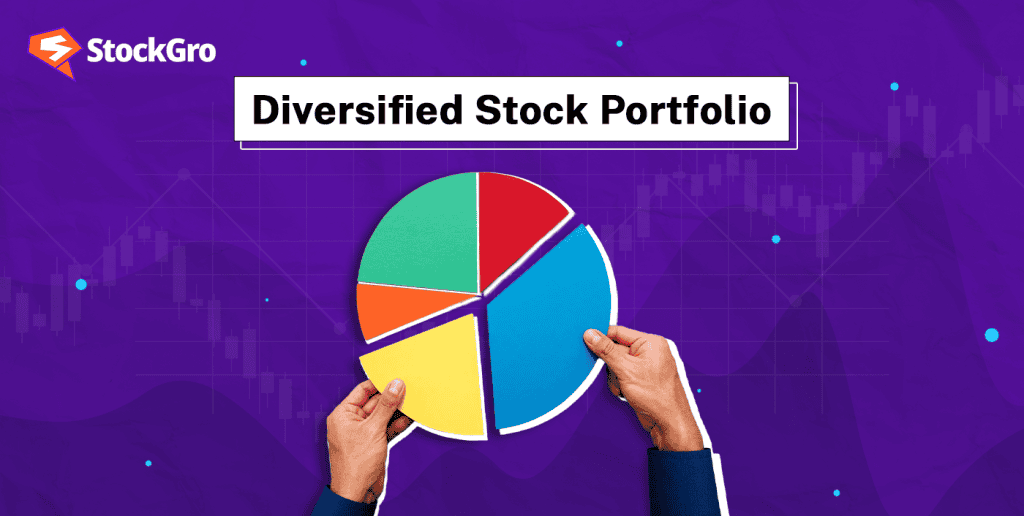
Stock investing has long been a popular way to create wealth. Purchasers of stocks in a company become partial owners and gain from its growth and profitability. The Bombay Stock Exchange (BSE) claims as of September 2024 that over 192 million registered investors exist. Furthermore as of September 2024, the National Stock Exchange (NSE) had registered investors exceeding 198 million.
Diversifying your portfolio is a tactic meant to reduce portfolio risk by means of investments in a spectrum of assets with different temporal performances. By lowering your risk, a diversified portfolio will help you to feel more future-ready.
The several advantages of diversification of a stock portfolio will be discussed in this article.
Must read: Everything you need to know about stock market portfolios
What is a diversified stock portfolio?
With a diversified stock portfolio, an investor divides their money among several stocks, sectors, businesses and even geographic areas. Reducing risk is primarily dependent on avoiding firm reliance on one stock or a particular market segment. Should one asset or industry underperform, others in the portfolio could balance off possible losses.
Diversification lowers unsystematic risk, which is associated with specific companies or sectors.
Example – Investors who solely owned airline stocks—that of Indigo or SpiceJet—saw notable losses during the COVID-19 epidemic as the travel sector collapsed under restrictions. Investors who diversified their portfolios by including sectors like technology (e.g., Infosys or TCS) or pharmaceuticals (e.g., Dr Reddy’s or Cipla) found fewer losses or even gains, though, since these sectors prospered during the epidemic.
This shows how distributing money among several sectors might guard against industry-specific downturns.
Also read: Diversification: Why it is important for your portfolio
Types of stock diversification
Many diversification techniques allow you to balance your portfolio over several stock market sectors.
- Sector diversification: This approach calls for investments in many spheres of the economy, including technology, healthcare, energy, consumer products, and finance. Having stocks in several sectors lowers your risk of a downturn compromising your whole portfolio.
For instance, energy stocks suffered during the COVID-19 epidemic while tech companies performed comparatively better. An investor owning both tech and energy stocks would have balanced gains and losses, reducing the total effect on their portfolio.
- Geographic diversification: Lowering your risk also comes from investing your money in companies all around many nations or regions. A diversified portfolio could call for stocks from developed markets like the United States or Europe as well as rising markets like Brazil or India. This keeps your whole portfolio safe should the government or economy of one nation fail.
For example, rising markets like India and Brazil showed resilience, while U.S. and European markets suffered greatly during the 2008 financial crisis. An investor with a geographically scattered portfolio would have lost money in developed markets balanced by stability in emerging ones.
You may also like: Currency basket explained: A portfolio diversification strategy
- Market capitalisation diversification: Investing in companies of different sizes helps to balance stability and development by means of market capitalisation diversification. Large-cap stocks give dependability; mid-cap stocks offer growth potential; small-cap stocks carry more risk but possibly higher returns.
- Dividend and non-dividend stocks: Dividend stocks provide consistent income provide consistent income, even if non-dividend stocks show more growth potential. Combining lets investors balance short-term income with long-term capital growth. While non-dividend stocks may shine during growth phases, dividend stocks often do better in erratic markets.
Benefits of stock portfolio diversification
- Risk reduction: Diversification helps to spread risk among several investments; hence, the effect of one stock on the whole portfolio is less if one of them performs poorly.
Keeping a variety of stocks from many sectors, businesses, and areas of the world helps investors lower their risk of significant losses. If the banking sector suffers, for instance, gains in the consumer goods or healthcare sectors can balance off those losses.
- Smoother returns: A diversified portfolio is more likely over time to produce regular and predictable returns. Investing money in multiple assets helps the portfolio to be less generally volatile.
Long-term financial planning is made possible by this consistency, which also helps investors to follow their strategy even in a declining market.
- Exposure to different opportunities: Diversification allows investors to seize prospects for development in several sectors and fields. By distributing their money among the expansion of new markets, new technologies, and other economic trends, investors can profit. This broad exposure increases your likelihood of earning more money.
- Potential for higher risk-adjusted returns: Diverse strategies help to produce better risk-adjusted returns. The returns, thus, are higher than the risk involved.
A diversified portfolio will acquire a better risk-return profile by means of a good mix of high-risk and low-risk investments. If one wishes the best returns while keeping a reasonable degree of risk, this balance is rather important.
- Psychological comfort: Knowing that your money is spread among several assets will help you to relax. When the market swings, diversification helps in controlling emotions and keeps the focus on the long-term financial objectives.
This mental ease helps people avoid making snap decisions based on transient changes in the market.
How to build a diversified stock portfolio
Maximising returns and lowering risk depends on a diversified stock portfolio. This detailed guide will help novices design a well-balanced investment plan.
Evaluate your risk tolerance before starting stock investment research. You really must know how much risk you are ready to accept. Do you want a more conservative approach, or are you seeking explosive expansion? Different self-assessment tools or financial advisory services can help determine your risk tolerance.
- Choose a mix of assets
Try to invest geographically (domestic and international markets) and across many sectors (including technology, healthcare, and finance). This lessens how much market volatility influences your whole portfolio. For example, increases in one industry might help offset losses during a recession in another.
If you have never tried stock investing, use mutual fund or ETF built-in diversification. Without much research, these funds pool money from many investors to purchase a diversified collection of stocks, so enabling the achievement of a balanced portfolio.
- Review and rebalance
Review your portfolio often to be sure it fits your risk tolerance and investing objectives. Variations in the market might change your asset allocation and call for rebalancing to keep your intended risk level.
Risks of over-diversification
- Diverse stock investments: Distributing money among several different stocks helps to lower portfolio volatility.
- Excessive diversification impact: Over-diversifying can cause returns to drop off, reducing the overall expected return on the portfolio.
- High-potential stocks: Starting with strong stocks like Reliance Industries and TCS, which are in strong markets and expected to grow, can provide great returns.
- Less-quality stocks: Including smaller or less-established companies to minimise risk can lower the portfolio’s overall potential for high returns.
- Market performance: Excessive diversification can make a portfolio’s performance align with the market, similar to an index fund like Nifty 50.
- Reduced potential for better returns: Excessive diversification diminishes the possibility of outperforming the market, making active stock selection less beneficial.
Bottomline
Managing risk depends on diversification, but too much of it can produce returns that are less than ideal.
Instead of unduly diversifying and sacrificing the performance of their portfolio, investors should strive to balance by choosing a reasonable number of premium stocks that provide the possibility for significant returns.
FAQs
- What is the most important reason to diversify a portfolio?
Diverse a portfolio helps to lower risk, thus it is mostly important. Diversification helps reduce the effect of underperforming assets by distributing investments among many asset classes, sectors, and geographical areas. This approach seeks to guarantee a more steady financial development by means of more consistent returns and protection against notable losses.
- Is it best to diversify your stock portfolio?
Yes, it’s generally advised to vary your stock portfolio. By spreading investments among many sectors, businesses, and asset classes, diversification helps lower risk. This approach can help to minimise losses from underperforming assets and offer more constant returns over time. Although it might not maximise short-term returns, it seeks to build a more steady investment portfolio.
- Is owning 30 stocks too much?
Usually regarded as a good balance for diversification, owning thirty stocks helps to spread investments across several sectors, so lowering risk. Managing too many stocks, however, can become tiresome and could reduce the possible returns from top-notch companies. Every stock in your portfolio should be understood and made sure fits your investing objectives.
- What are the disadvantages of diversification?
By distributing investments too thinly and resulting in reduced returns from high-performance sectors, diversification can restrict growth prospects. It calls for fresh knowledge and abilities, which may prove difficult to pick up. Over-expansion affects all aspect of the company by straying resources and attention. Furthermore, a very diversified portfolio might find it difficult to react fast to changes in the market, so restricting agility and innovation.
- What are the 50 80 rule stocks?
Introduced by trader Mark Minervini, the 50/80 rule for stocks holds that once a major market-leading stock reaches a significant peak, there is an 80% chance it will fall by 50% and a 50% chance it will fall by 80%. This rule underlines the need of careful investing since it shows the possibility of significant declines in high-flying stocks following top out.

